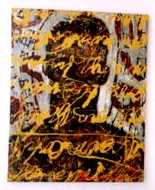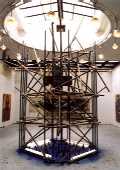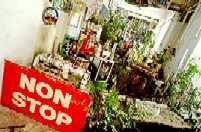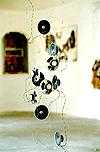 |
Vol 1, No 14
27 September 1999 |
|
|
 C U L T U R E:
C U L T U R E:
Manifestly Refreshing Kazi Stastna This spring, when posters for and rumours of a new project entitled "The Last Underground" started appearing around Prague, it looked like the city's arts scene was finally going to get the boost it desperately needed - an innovative, independent, multi-media gallery of contemporary art. The project kicked off with three days of performances, installations, concerts and general artsy "gatherings" at an impromptu gallery space above Prague's Roxy Club, known as one of the city's more experimental performance venues. With artists from 11 different countries participating, the evenings in the spacious, rough-hewn gallery were dynamic conglomerations of several languages, types of movement, music and art. The feeling was incredibly cosmopolitan and surprisingly pleasant and pretension-free. Artists from several corners of the world were mingling, enjoying the cheap beer and wine and free catering and generally happily milling about amidst sculptures, soundscapes canvases, film loops, huge multi-media collages, scratching DJs and performing orchestras. One had the uncanny (and rare) feeling that whatever it was that one was in the midst of, it was all working. Unfortunately, the event ended, the works were dismantled, the international participants retreated to their respective countries and the Prague scene was back in the doldrums again. What seemed like a much-needed injection of new cultural blood into the city turned out to be yet another fleeting moment. The reasons behind its failure to take hold in the city are indicative of a problem that is pervasive in the Czech Republic on several fronts. It can perhaps be described as a general fed-up-ness on the part of people - both local and foreign - attempting to launch any number of new initiatives within the country. Whether it be those attempting to jolt the government into action on issues of EU integration or those working to establish new cultural projects, the results of their efforts are usually the same: frustration, exasperation, leading to apathy and, eventually, retreat. The overall consequence is the view of the Czech Republic as a cheap transit point; a place to bide one's time until one can get to somewhere worthwhile - potentially, a place to run a low overhead operation for doing things elsewhere. Although the phenomenon is widespread, it has particular resonance in the country's capital and specifically, in the capital's cultural life. There is no sense of a permanent urban life in Prague - something that remains after the tourists go, taking the cheesy "cultural events" with them. The lack of a significant cultural core that remains open to influences and is constantly changing and re-examining itself but nevertheless remains an integral, and permanent, part of the city is strikingly apparent. Instead, the city's cultural fabric is made up largely of insular Czech cliques which remain locked within their genre, frustrated Czech artists who flee when they can or retreat into an unproductive defeatism and equally frustrated foreign artists who retreat into expatriate communities or use Prague merely as a temporary springboard from which to do interesting work elsewhere. Despite the droves of international tourists that descend upon the city every year, the relatively large expatriate community and the oft-heard rhetoric describing Prague as a "crossroads of culture," one does not have the sense, when walking the streets, of a home-grown cosmopolitanism. This extends past a merely subjective feeling when one follows the city's cultural calendar for any length of time. Truly innovative events are sporadic and few and far between. Most of time, a general cultural humdrum prevails, which is neither here nor there. Never mind a scene, there is barely even a sign of a pulse. Occasionally, when one does stumble upon an innovative project more often than not it leads one into a deep depression, as these projects usually remain unacknowledged and under financial threat or - as in the case of the excellent experimental mime theatre Alfred ve dvore - get eradicated altogether.  Such was the case (of depression that is) when I sat down with Czech-Canadian artist Marek Schovanek and Allison Lewis, two of the organisers behind "The Last Underground" and Beyond Art - a similar multimedia event which took place at the end of July at Prague's Manes gallery. Both events were run under the auspices of the civic organisation Manifest, founded in December 1998 by Schovanek, Lewis and some of their colleagues and friends. So far, the organisation has survived largely on the personal gusto and hyper energy of its founders and the contacts they maintain throughout the world - wracking up a monthly 20,000 Czech crown (USD 600) e-mail/phone-bill in the process. Working out of Allison's bedroom in Prague, the organisation has managed to produce two large, international, multi-media performance exhibitions in six months and is currently running a small version of The Last Underground in Tokyo. Unfortunately - and here comes the depression - their experiences in the Czech Republic leave little hope that their projects (or even similar ones) will become a regular part of the Prague arts scene. CER: What is Manifest? Marek Schovanek: Manifest is an organisation representing contemporary art worldwide. That's a general statement, but that is probably what we try to do with it. Do you have a core group of members? MS: There are about five or six people who have worked for the last six months on these projects and outside of that there are about another 15 people that support us. We run on a lot of momentum. Six people make the basis of it and then there are a lot of people who help us; there are people doing Internet marketing, writing, people from the press corps, the arts - it's all walks. It covers a broad range of abilities. If we were all artists, we would all be headless and brainless and nothing would happen. Do the artists involved in the projects such as The Last Underground and Beyond Art also consider themselves to be part of Manifest?  MS: Manifest is just an organising body, for transporting pieces. We're not after making the ole... what is it called... the jolly riders or something... Allison Lewis: Merry Pranksters. MS: ...yeah, Merry Pranksters. We're not producing the Merry Pranksters show or anything. The Last Underground was very international. Was this also the case at Beyond Art? MS: I think we touched a lot more Czechs this time. We engaged the Czech audience in a broader range than last time. Last time, out of the woodwork came everybody; this time, out of the woodwork came everybody but it was more partial to Czechs. Was that due to location? MS: Location, and our advertising campaign was a little broader. The Last Underground took place in a location drastically different from the well-established gallery space with a long history environment of the Manes. Can you give us a little background on this unique space? MS: We built a gallery in co-operation with the Linhart Foundation (the organisation which owns half of Prague's Roxy club, above which the gallery was built) and it was maybe the first time in the history of the Czech Republic that a gallery got built to house an exhibition as opposed to an exhibition getting built to sit in a gallery space. We did the opposite - we built a gallery that would facilitate what was in there. And then it dissolved? MS: We gave it back to the Linhart Foundation and we suggested they use it as an artist initiative-run, work-in-progress studio space. So we just gave it away. Manifest makes charity. Manifest is a charity organisation. We give away space and create opportunities for people to work - that was the outcome of that. AL: The Linhart Foundation rents it from the Jewish Community They have plans to renovate it, maybe turn it into an Internet cafe. Originally, when I heard about The Last Underground project I was excited because I understood it as new permanent gallery and it seemed to be filling a niche that needed to be filled here in Prague - a small, independent, experimental gallery. MS: We did open it as a potential space. We spent I think a million crowns or something and killed about 20 people to build the space. It was a huge effort and we turned it over to the Linhart Foundation for that purpose initially. We said: Here - take it. Use it like this. Here's the initiative, here's the energy, here's 120,000 crowns (USD 37000) in propaganda and advertising for the space. It's a lot of money, a lot of energy - take it, that's your start. AL: They didn't believe that we could do it. MS: They didn't believe we that we could transport it, and at the time we came over to do something with the damn gallery they weren't ready to take the gallery and make the next exhibition or even - in the two months that they had - to put in a floor or secure at least a basic structure for this damn place. They were incompetent. So they couldn't transport it as another exhibit. They were left with one functioning room and four broken rooms. They couldn't take responsibility for what we gave them. Which is a shame. AL: I think they're starting to do a bit of fundraising now.  MS: They'll do it in the fall, but we were giving them companies for two million. They'll fix it for you - here's the contact for the floor, the wall the door... nothing. They didn't take it. They threw it away. You would assume that if you're offering somebody 1000 square metres which is the only breath of fresh that they've had here for ten years that they would jump on this thing and build the floor out of their own mother to keep this place alive. But nothing - no reaction. They made a stipend - a process in which they engaged artists to come there and use it as a painting studio to keep it active. Two people paint there now after two months. It's a joke. There was no reaction - no transport, no execution. It just fell flat on its face. There it is - you want this? You don't have to pay 120,000 crowns for a month's rent you just have to organise yourself and make an exhibition. No, nobody. Okay. That's where we are. If anybody cries, let them cry. That's what they're here for. The atmosphere during The Last Underground was very cosmopolitan. Is that a feeling that is represented permanently here? MS: That was the first time that anybody got something like that here. We gave them something that rarely exists like this in any part of the world. It is not that common in the West to walk into an exhibition and have there be such a multi-level of engagement. These are decadent pieces, and they rarely exist. This was primarily a volunteer effort - that is another thing that is part and parcel of The Last Underground's success: that everybody - from artists to performers such as Atari Teenage Riot, who can get 10,000 Deutschmarks for a gig - donated their time and energy to make The Last Underground. So it was a prototype for what art and culture could be represented as in a multi-level environment. And it was a volunteer effort. Usually, you don't create that kind of atmosphere anywhere unless you're going to engage massive funding. To produce an exhibition like The Last Underground in the West, I think you'd be looking at spending close to half a million marks. Is any part of the atmosphere you're talking about sustainable over a longer period of time? Is there a living, breathing exchange of these kinds of international multi-level influences in the Czech artistic community, for example? MS: There isn't really such an active arts scene here. They don't do much. They don't take initiative, and they sit on their ass and wait for handouts, and they make static exhibitions in the spaces that be. That is why the Czech content was excluded in The Last Underground, because they didn't believe that you can manifest out of nothing this type of atmosphere, this type of event. We engaged about six people in the beginning and asked them - would you want to be involved in building this gallery and representing yourself under this format? Most people said, well yes, it's a lovely idea you have, but we don't believe in the time at hand you can pull this off, and we don't believe you can have such a broad effect as you're telling us and we'll see. So by the time they tell you they'll see, we really don't have time to talk to them anymore. You need people that will say yes and that will say yes twice. You don't want anybody at a 100 per cent you want them at a 110. At the time we were doing The Last Underground, we had people at a 110, and we couldn't take people that dragged their ass. We couldn't take these people. So the environment was purely artificial. It had nothing to do with the Czech Republic in a sense. So is it just happenstance that you are founded here as an organisation. Do you feel based here? MS: No. I don't think it matters. We're here because we are here. Just coincidence? MS: Let's say it's coincidence. We're here. It's the centre of Europe. You can reach East and West from here. It's not a bad location. You're running a low overhead for production, and you can run that production from here into the West. It's not a bad launching pad. Do you have any aims of integrating younger Czech artists, many of whom are frustrated with the arts scene here? Then it's up to their initiative. They can bitch all they want, but it's up to their initiative to change something. When they have that initiative, then maybe they can change something. It's not my problem. So you see it as their own thing. You don't want to integrate them... MS: I can integrate them into anything we produce, but I am not interested in changing the Czech arts scene. I am interested in having an international consequence to what we're doing. And I think we do. I'm not worried about local anything or villages anywhere. I'm trying to get the best pieces and put them into this context. One of your projects has also taken you to Sarajevo. What was feeling of implementing your type of project in that environment? MS: It was charity again. They needed it. We had contacts there and they needed it. Much of the writing on your website talks about creating an environment and combining art for art's sake and existing everyday realities, how did this philosophy apply there? MS: You're certainly getting a different result when you make something like that in Sarajevo. You're dealing with a war zone, and that war zone is going to have a context of its own, and you're going to be working in that environment. You're going to be assimilating that environment. So what kind of things specifically struck you? MS: In Sarajevo, we did fast things. It was fast, temporary, because you couldn't really go in there and engage yourself, build monumentals or permanent structures. It wasn't a gallery. We took a building and we made everything in space and time. Artistically, you were working in that space and what it gave you. So it was a more pragmatic approach? AL: Yeah. We stayed in a building on the front lines and just spray-painted and made murals there and held a party and had a fashion show. Five or six hundred local people came. Did you have chance to interact with the locals? AL: We had to leave the next day. MS: It was a mercenary mission. We went in with a front-line piece, dropped it and ran out. Now, we are doing a more institutionalised proposal for the national gallery in Sarajevo. That way we can actually engage Sarajevo at a higher level and go in there, drop in a similar piece, but drop it in at a higher level. This entails a lot more engagement, a lot more politics, a lot more bureaucracy and a lot more technical organisation. Much of your promotional material is structured around the presentation of your actions within a total concept. MS: It should be like that. From a viewers perspective, do you find that people experience your exhibitions as a concept? MS: I don't know how that transports in people's little souls - whether they link what we're telling them and what they're interpreting. I can't be a judge of that. But I think it does transport quite close to what we're saying. Sometimes, it seems that people have the most trouble with the very pieces that are trying the hardest to be "public" art or incorporating open environments. MS: They're more challenging than walking in and having an interpretation written for you. We're writing you an outline. It's about an experience. Do you think people are patient enough to figure it out? [If not] then it's the loss of society. If people are too stupid that they don't have five minutes to use their eyes for what they're meant to be used for, then it's their weakness. And what do you do with that? If you can't see, you're blind, you're deaf and you don't want to see and you're not blind and you aren't deaf and you can't feel anything and you're completely jaded and dumb and blind, it's really hard to affect you in any context, isn't it? Interview conducted by Kazi Stastna Manifest's website is HERE
|
|
![]()
Copyright (c) 1999 - Central Europe Review and Internet servis, a.s.
All Rights Reserved